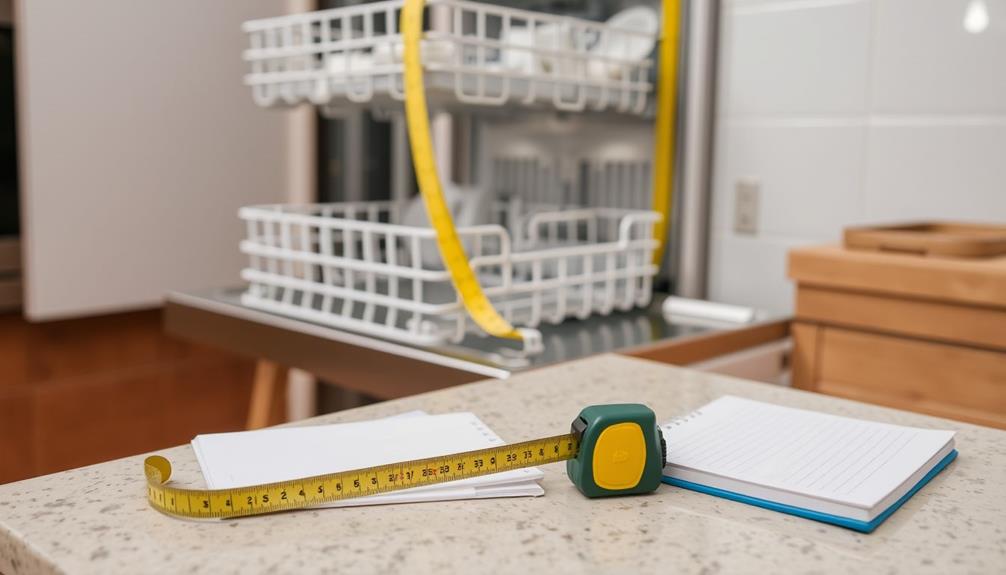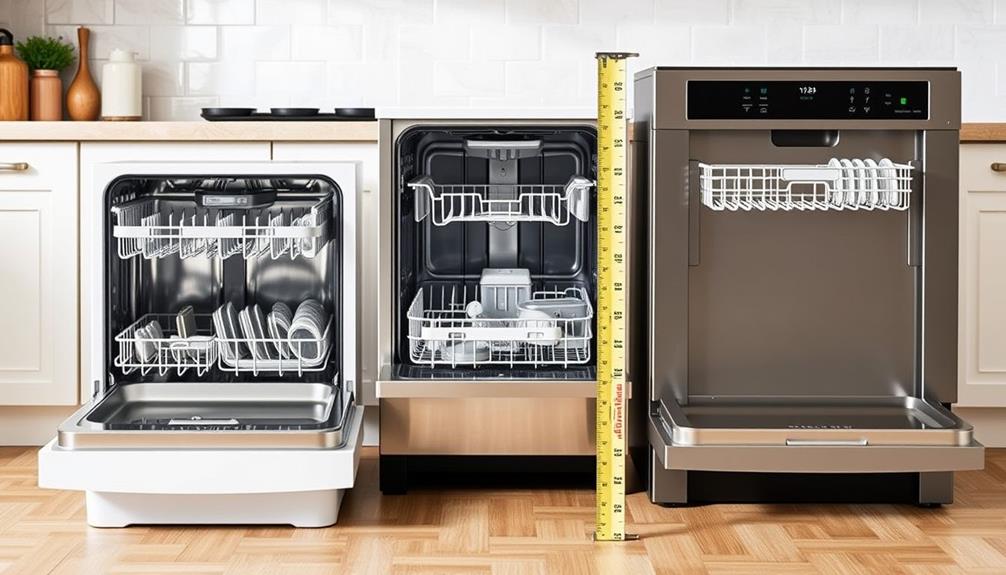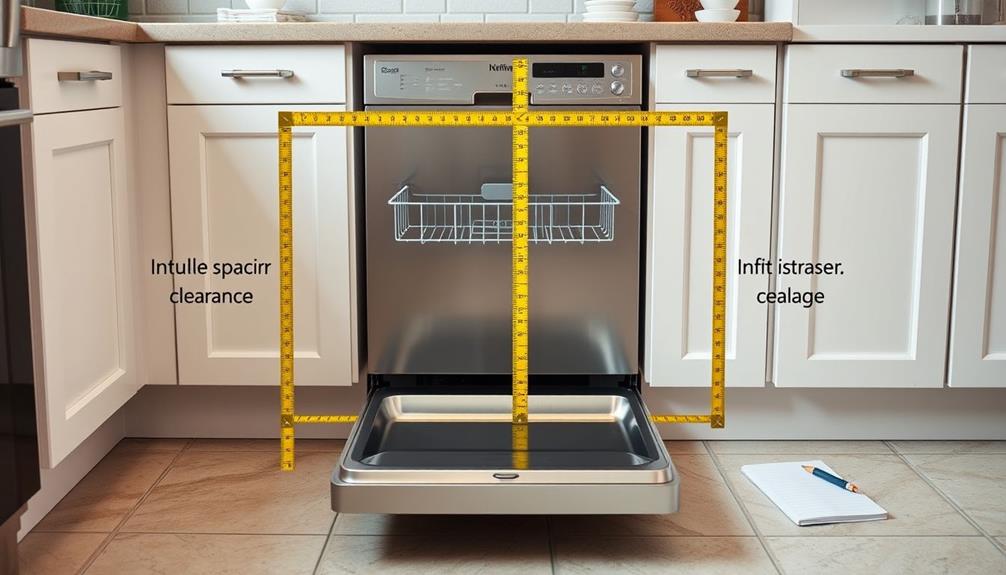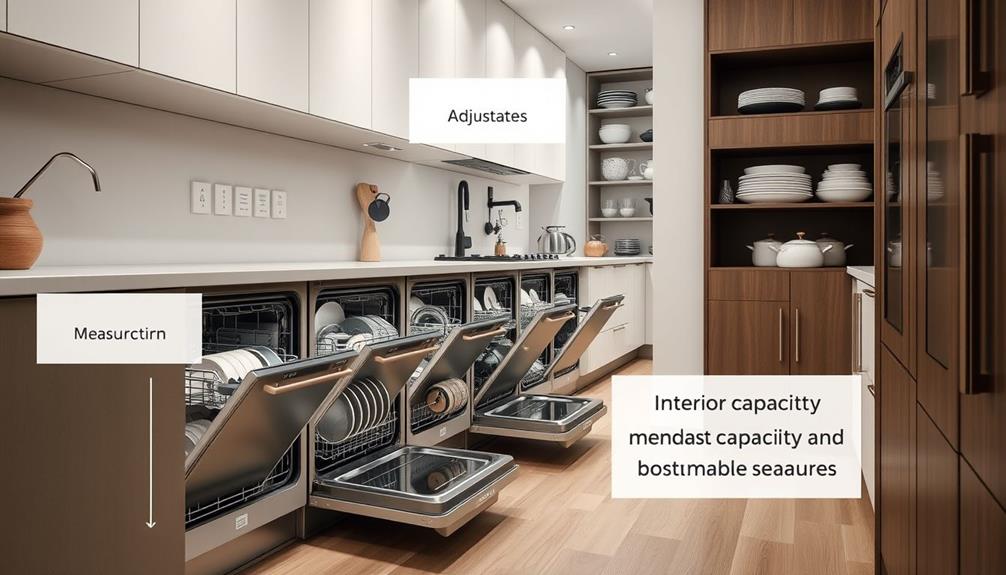When selecting the appropriate dishwasher size for your home, start by accurately measuring your kitchen space. Standard dishwashers are typically 24 inches wide and can hold 10 to 12 place settings. Be sure to also consider height and depth, making sure there is enough space for door swing and proper ventilation. Depending on your family’s needs—larger families or those who often entertain may require a model with additional capacity or adjustable racks. Don’t overlook how it complements your kitchen’s style and functionality. By following these guidelines, you can find the perfect fit for your household. There’s a wealth of information available on this subject.
Key Takeaways
- Measure the height, width, and depth of your cabinet space to ensure a proper fit for the dishwasher.
- Consider your household size to determine if you need a standard, compact, or oversized dishwasher.
- Ensure at least 27 inches of space in front for door swing and usability when loading/unloading dishes.
- Account for ventilation requirements, maintaining 1-2 inches of clearance around the appliance for optimal performance.
- Evaluate the dishwasher's interior capacity and features, such as adjustable racks and third racks, for efficient dish loading.
Importance of Accurate Measurement
Accurate measurement is vital when choosing a new dishwasher. To guarantee a perfect fit, you need to measure the space where you plan to install your new appliance. It's also helpful to take into account key factors in choosing a home cleaning service that might influence your kitchen layout.
Start by measuring the height, width, and depth of your cabinet openings. Standard dishwasher sizes usually come in at 24 inches wide, 24 inches deep, and 35 inches high, but it's important to confirm these dimensions for your specific model.
Don't forget to measure the depth as well; this helps avoid potential obstructions like pipes or electrical outlets that could interfere with installation.
Also, check the opening at both the top and bottom to verify that the width remains consistent. This step prevents gaps that could lead to installation issues.
An accurate measurement guarantees compatibility with your existing plumbing and electrical systems, making for an efficient operation post-installation.
By taking the time to measure the space properly, you'll save yourself from costly modifications and potential usability problems down the line.
Key Measurements to Consider

Once you've measured your installation space, it's time to focus on the key measurements that will guarantee your new dishwasher fits perfectly.
Start with the height; measure from the floor to the bottom of your countertop, which typically ranges from 34 to 36 inches. This ascertains your dishwasher fits snugly under the counter. Remember that some models may require electricity for ignition or electronic controls, so considering the HVAC maintenance in your home can also affect your kitchen's functionality.
Next, look at the width. Standard dishwashers are usually 24 inches wide, so measure the cabinet opening from left to right at both the top and bottom. Always use the smaller measurement to ascertain a proper fit.
For depth, measure from the back wall to the front edge of the cabinet. This usually falls between 24 to 25 inches, but you'll need to leave 21 to 27 inches of space in front for the door swing and usability.
Tools Needed for Measurement

How can you confirm your dishwasher fits perfectly? To guarantee a proper fit, gather a few essential tools before you begin measuring. Start with a contractor's tape measure, which is vital for taking accurate measurements of the cabinet dimensions, including the width, depth, and height.
With the tape measure in hand, you can get precise figures that will help you choose the right dishwasher size. Additionally, consider measuring the space where the dishwasher will be installed to account for any obstacles that might affect the fit, such as plumbing or electrical outlets. It's also wise to check for any existing appliances that might require similar safety standards to confirm compatibility.
Be certain to have a pencil or marker to mark measurement points on the cabinet or countertop. This will give you clear references when you're comparing different models. Keep a notepad nearby to jot down all your measurements, confirming they're recorded accurately for future shopping trips.
Additionally, consider taking photos of the measured space with your smartphone. These images provide visual context, making it easier to verify dimensions later on. If you have a level, it could be helpful to check for any uneven surfaces that might affect the installation process.
With these tools ready, you'll be well-prepared to measure the space efficiently and effectively.
Step-by-Step Measurement Process

With your tools ready, it's time to start the measurement process. First, measure the height from the floor to the bottom of the countertop in three spots: left, middle, and right. This guarantees your new dishwasher fits properly, typically within the range of 34-36 inches.
For a prime kitchen design, consider how the DIY Kitchen Wall Decor can complement your new appliance. Next, measure the width of the cabinet opening at both the top and bottom. Confirm the standard width of 24 inches, using the smaller measurement for accuracy.
Now, focus on the depth. Measure from the back wall to the front edge of the cabinet. Make certain there's at least 24-25 inches for the dishwasher, plus an additional 21-27 inches in front for door clearance.
Don't forget to check for any obstructions, like pipes or electrical outlets, that might affect the installation space around the dishwasher.
As you take these measurements, record them accurately. It's a great idea to capture photos for reference, guaranteeing you avoid mistakes when selecting your new appliance.
Common Measurement Mistakes

When measuring for your new dishwasher, it's easy to overlook important factors like flooring thickness and door swing space. Failing to take into account these details can lead to a frustrating installation experience.
Additionally, misjudging ventilation requirements might compromise your dishwasher's performance, so it's vital to get these measurements right.
Ignoring Flooring Thickness
Neglecting to factor in flooring thickness can lead to significant installation headaches with your new dishwasher. When you're measuring for the height of your dishwasher, it's essential to measure from the floor to the bottom of the countertop and subtract the flooring thickness. Standard materials like tile can add an extra 1/4 to 1/2 inch, which could impact your dishwasher's clearance under the countertop.
Additionally, using a well-draining soil mix for your plants can provide a more stable environment while you navigate these home improvements.
If you ignore this detail, you might find that your dishwasher is too tall, leading to installation issues and preventing the door from opening properly. To avoid this problem, be diligent about your measurements. Make certain that you account for the thickness of any flooring material you have in place.
Also, think about potential future flooring changes. If you plan to update your flooring later, an increase in thickness could create fit issues down the line. By measuring accurately now, you can save yourself from frustrations and costly adjustments later.
Ultimately, verifying the correct height of your dishwasher can make a world of difference in your kitchen's functionality.
Overlooking Door Swing Space
Many homeowners overlook the importance of door swing space when selecting a dishwasher, which can lead to frustrating installation challenges.
It's crucial to measure the cabinet and verify there's enough clearance for the door to fully open. Most dishwashers require at least 2 inches of space between the open door and adjacent walls or cabinets for proper functionality.
Additionally, considering the layout and flow of your kitchen can greatly enhance your overall experience, making it easier to navigate around the space while loading and unloading dishes. For tips on improving your kitchen design, check out simple changes can elevate overall aesthetics.
If you don't account for this, you could limit access to the dishwasher, making it difficult to load and unload dishes efficiently.
Standard dishwashers typically swing open at least 90 degrees, so if your space is cramped, you might find yourself struggling to reach inside.
Moreover, ignoring the door swing space can damage surrounding cabinetry or walls if the door hits them when opened.
To avoid these issues, it's advisable to measure and mark the door swing space on the floor before you install your dishwasher. This visual can help you gauge the area you need, confirming that your new appliance fits seamlessly into your kitchen and functions effectively.
Taking these steps will save you time, effort, and potential repair costs down the line.
Misjudging Ventilation Requirements
Guaranteeing proper ventilation is fundamental for your dishwasher's efficiency and longevity. Misjudging the ventilation requirements during installation can lead to serious issues, including overheating and decreased performance.
Most dishwashers require a minimum of 1-2 inches of clearance between the appliance and adjacent walls or cabinetry. This space around the dishwasher is essential for adequate airflow, which keeps the unit cool and functioning at its best.
Moreover, just as with a home theater setup, where ideal placement and configuration are imperative, proper ventilation in dishwashers also plays a significant role in their functionality.
Ignoring these ventilation needs can't only increase noise levels but also risk potential damage to your appliance, ultimately shortening its lifespan.
To prevent such misjudgments, always review the manufacturer's installation manual for specific ventilation requirements. Additionally, consider the location of vents to guarantee they're not obstructed by nearby cabinets or other appliances.
Properly maintaining this airflow will enhance your dishwasher's overall performance and efficiency. By taking the time to address ventilation needs, you'll create a more reliable and quieter kitchen environment, allowing your dishwasher to serve you effectively for years to come.
Don't overlook this important aspect; it can make all the difference in the long run.
Understanding Dishwasher Size Categories

When you're selecting a dishwasher, it's crucial to understand the different size categories available. Knowing the dimensions of each type can help you make an informed choice that fits your kitchen and needs.
Consider how your kitchen design aligns with modern farmhouse decor trends to guarantee a cohesive look in your space.
- Standard: Typically measures 24 inches wide, 24 inches deep, and 35 inches tall, ideal for most households.
- Compact: Designed for smaller spaces, these models are 18 inches wide but share the same depth and height as standard dishwashers, making them perfect for apartments or limited kitchens.
- Oversized: Ranging from 30 to 42 inches wide, these dishwashers cater to larger families or those who frequently entertain, but require bigger cabinet openings for installation.
You might also consider portable dishwashers, which usually measure 24 inches wide, 27 inches deep, and 37 inches tall.
These offer flexibility without needing a permanent installation, making them a great option for renters or those with limited space.
Space Requirements Around Dishwashers

When planning for your dishwasher, you need to take into account the space around it carefully.
Confirming that there's adequate clearance not only allows the door to open fully but also facilitates proper ventilation, which is essential for efficient operation.
It's important to be mindful of clogging remedies that may involve plumbing adjustments when installing appliances.
Make certain to check the installation manual for specific spacing requirements to guarantee everything functions smoothly.
Minimum Clearance Space Needed
Having the right clearance space around your dishwasher is vital for efficient operation and ease of use. To guarantee your appliance fits well and functions properly, you need to adhere to specific space requirements.
Additionally, maintaining a healthy lifestyle, including proper kitchen organization, can streamline your cooking and cleaning processes, ultimately supporting your wellness goals through healthy lifestyle blogs.
Here are some key considerations for minimum clearance around your dishwasher:
- Maintain at least 27 inches of open space in front for easy loading and unloading.
- Leave a minimum of 2 inches of clearance between the open door and any adjacent wall or cabinet to guarantee proper access.
- Standard dishwashers should be 0.5-1 inch smaller than the cabinet opening to facilitate a proper fit and installation.
It's important to consult the installation manual for your specific model, as space requirements can vary.
Additionally, don't forget about ventilation space; adequate airflow is necessary to prevent overheating and support peak performance.
Properly planning these clearances won't only enhance your dishwasher's functionality but also make your kitchen more user-friendly. By taking these factors into account, you'll be well on your way to a successful dishwasher installation.
Open Door Considerations
Proper clearance isn't just about the space around your dishwasher; it also includes considerations for when the door is open. You need to verify there's at least 2 inches of space between the opened door and any adjacent walls or cabinets. This distance allows for full access and functionality when loading or unloading dishes.
Additionally, it's crucial to maintain at least 27 inches of clearance in front of the dishwasher. This space creates a comfortable area for you to move around and efficiently load or unload your dishes.
Standard dishwashers typically require a specific door swing space, so make sure there's no obstruction from nearby furniture or appliances that could interfere with the opening.
Before you install your dishwasher, take the time to measure for a dishwasher properly. Always consult the installation manual for specific spacing requirements, as each model may have unique features that affect how it fits in your kitchen.
Ventilation and Access Space
To guarantee your dishwasher operates efficiently, it's essential to take into account the ventilation and access space around it. Proper spacing not only guarantees smooth operation but also aids in installation and maintenance.
Here are some key considerations to keep in mind:
- Open Space: Confirm there's a minimum of 27 inches of open space in front of the dishwasher for comfortable loading and unloading.
- Adjacent Clearance: Leave at least 2 inches of space between the open door of the dishwasher and any adjacent wall or cabinet. This prevents obstruction and enhances accessibility.
- Size and Ventilation: Standard dishwashers are designed to be 0.5-1 inch smaller than the cabinet opening, allowing for proper ventilation during operation.
Before you proceed, measure your available space carefully.
Don't forget to check the installation manual for specific requirements, as different models may have unique needs.
Also, consider the placement of hoses and electrical outlets; you want to confirm there's enough room for these connections without hindrance.
Following these guidelines will help you create an effective and functional kitchen space.
Aesthetic Considerations

When selecting a dishwasher, it's crucial to contemplate how it fits aesthetically within your kitchen. The right choice can create a cohesive look that enhances the overall design. Consider the dishwasher dimensions and how they align with your cabinetry. Pocket handle models offer a sleek, flush appearance, while bar handle designs may disrupt the visual flow.
| Design Type | Aesthetic Impact |
|---|---|
| Front Control | Easy visibility, adds usability |
| Top Control | Streamlined look, hidden controls |
| Finish Matching | Unifies appearance with other appliances |
Choosing a dishwasher that matches the finish of your kitchen appliances—like stainless steel or black—can greatly enhance your space's aesthetics. Front control dishwashers allow for easy cycle selection, contributing to both usability and appearance. On the other hand, top control models keep controls hidden, reducing clutter on the appliance's front.
Interior Capacity and Features

Choosing a dishwasher involves more than just aesthetics; you also need to take into account its interior capacity and features. Standard dishwashers typically accommodate 10 to 12 place settings, making them ideal for average-sized households.
However, if you frequently entertain or have a larger family, you'll want to contemplate models with additional features.
Here are some key features to look for:
- Third rack: This provides extra space for utensils and smaller items, enhancing overall capacity.
- Adjustable racks: These allow you to customize the interior layout, accommodating larger or oddly shaped dishes.
- Effective loading techniques: Proper arrangement can greatly improve cleaning efficiency and coverage.
Understanding the number of place settings and available features helps you select a dishwasher that meets your specific needs.
Frequently Asked Questions
How Do I Know What Size Dishwasher to Buy?
To know what size dishwasher to buy, measure your space and consider your household's needs. Think about how often you wash dishes and if you need features like adjustable racks for better capacity.
How Much Space Do You Need on Either Side of a Dishwasher?
You'll need at least 2 inches on either side of your dishwasher for proper installation. Don't worry; this space guarantees efficient operation and prevents any interference with your cabinets or walls.
What Is the Most Common Size of a Dishwasher?
The most common size of a dishwasher is 24 inches wide, 24 inches deep, and 35 inches tall. This standard size fits most kitchen cabinetry, accommodating 10 to 12 place settings for average households.
What Size Dishwasher for a Family of Four?
For a family of four, you should opt for a standard 24-inch dishwasher. It'll fit 10 to 12 place settings comfortably, ensuring you've got enough space for daily dishwashing without hassle.
Conclusion
Choosing the right size dishwasher for your household isn't just about fitting it into your kitchen; it's about maximizing efficiency, enhancing convenience, and elevating your culinary experience. By accurately measuring your available space, considering your daily needs, and understanding the different size categories, you'll find a dishwasher that complements your lifestyle. So, measure wisely, choose thoughtfully, and enjoy the seamless blend of functionality and design that the perfect dishwasher brings to your home.










